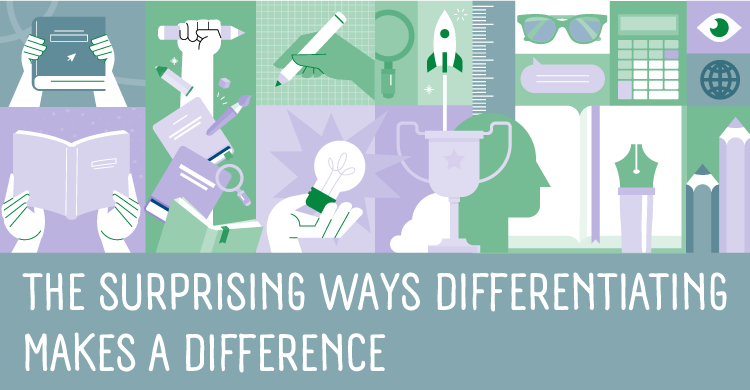Keys to making instructional differentiation natural and easy
In my role as an instructional coach and reading specialist, I have heard teachers discuss how they differentiated their assignments or assessments. As an adjunct teacher at various colleges, I’ve seen lesson templates for novice educators that include space where preservice teachers can explain how they will differentiate instruction for their students. And finally, with the advent of ChatGPT, AI will now create differentiated plans for you.
Carol Ann Tomlinson (2000), the guru of differentiation, defined the term this way in Reading Rockets: “Differentiation means tailoring instruction to meet individual needs. Whether teachers differentiate content, process, products, or the learning environment, the use of ongoing assessment and flexible grouping makes this a successful approach to instruction.” While we know active planning and attention is the foundation of differentiation, we also know that differentiation should be regarded as a philosophy—the purpose of your educational ideology or convictions. It should not be something that is done to students.
In the article “A Practical Guide to Planning for Intentional Differentiation,” John McCarthy (2021) talks about the process regarding differentiation. He states, “Process is about the different ways that students make sense of the content. Students need frequent experiences of sense-making through a variety of different ways and opportunities.” When differentiation becomes your philosophy, a part of your natural teaching repertoire, it no longer becomes a thing that has to be done. Rather, it becomes a process—a series of steps taken in order to achieve an end goal.
As you (and possibly AI) create your next lesson, consider differentiation not as a thing that is done nor as a space on a template or a box that is checked during teacher evaluation. Rather, consider differentiation a part of your teaching philosophy. When you’re able to apply differentiation as a philosophy, you no longer have to ask yourself, “How will I differentiate this lesson?” Instead, you unconsciously and routinely build lessons where differentiation is a natural part of your lesson creation method.
How to put organic differentiation into practice in your classroom
Let’s say you are writing a lesson plan focusing on students finding the main idea in text—a rather straightforward task. But instead of asking yourself how you will differentiate the lesson, create stations that encourage students to determine which way they will best learn this task. The first station consists of a short text. After reading the text, students complete a concept map—a visual representation of information. In the second station, students again will read a short piece of text and search for keywords that are repeated and highlight those words with a highlighter. At the third station, allow for a group of students to read the short text and talk about what they think the main idea is, and ask them to keep track of their responses.
In this scenario, the teacher is not “doing” differentiation, but rather, creating opportunities to learn in different and preferred ways. After students have gone through each station, ask them what station they preferred—how did they learn to find the main idea? Some students might argue that station one—the visual representation—offered them the best mode of learning. Another group might contend that working on their own quietly helped them achieve the goal. Finally, there might be a group who appreciated being able to talk through the possible responses and determine what they perceived to be the main idea.
It’s time to change the mindset regarding what we “do” to students. Instead, consider differentiation as a process rather than a task. As our educational philosophy has probably shifted over the years, the way we see differentiation has probably changed as well. It’s time to think of differentiating instruction as a purpose where students determine the way they will learn best.

Peg Grafwallner
Peg Grafwallner, M.Ed., is an Instructional Coach/Reading Specialist in Milwaukee, Wisconsin, with nearly 30 years of experience. As an English teacher, at-risk educator, instructional coach and reading specialist, she has taught advanced English and developing readers. Currently, Peg collaborates with teachers to seamlessly embed literacy (reading, writing, speaking, and listening) into their discipline without disrupting the integrity of the content.

